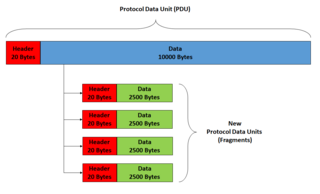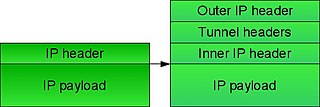The Internet Control Message Protocol (ICMP) is a supporting protocol in the Internet protocol suite. It is used by network devices, including routers, to send error messages and operational information indicating success or failure when communicating with another IP address. For example, an error is indicated when a requested service is not available or that a host or router could not be reached. ICMP differs from transport protocols such as TCP and UDP in that it is not typically used to exchange data between systems, nor is it regularly employed by end-user network applications.

Internet Protocol version 4 (IPv4) is the fourth version of the Internet Protocol (IP). It is one of the core protocols of standards-based internetworking methods in the Internet and other packet-switched networks. IPv4 was the first version deployed for production on SATNET in 1982 and on the ARPANET in January 1983. It is still used to route most Internet traffic today, even with the ongoing deployment of Internet Protocol version 6 (IPv6), its successor.

Internet Protocol version 6 (IPv6) is the most recent version of the Internet Protocol (IP), the communications protocol that provides an identification and location system for computers on networks and routes traffic across the Internet. IPv6 was developed by the Internet Engineering Task Force (IETF) to deal with the long-anticipated problem of IPv4 address exhaustion, and was intended to replace IPv4. In December 1998, IPv6 became a Draft Standard for the IETF, which subsequently ratified it as an Internet Standard on 14 July 2017.
The Internet Protocol (IP) is the network layer communications protocol in the Internet protocol suite for relaying datagrams across network boundaries. Its routing function enables internetworking, and essentially establishes the Internet.
In computer networking, the maximum transmission unit (MTU) is the size of the largest protocol data unit (PDU) that can be communicated in a single network layer transaction. The MTU relates to, but is not identical to the maximum frame size that can be transported on the data link layer, e.g., Ethernet frame.
In computer networking, the User Datagram Protocol (UDP) is one of the core communication protocols of the Internet protocol suite used to send messages to other hosts on an Internet Protocol (IP) network. Within an IP network, UDP does not require prior communication to set up communication channels or data paths.
A virtual private network (VPN) is a mechanism for creating a secure connection between a computing device and a computer network, or between two networks, using an insecure communication medium such as the public Internet.

IP fragmentation is an Internet Protocol (IP) process that breaks packets into smaller pieces (fragments), so that the resulting pieces can pass through a link with a smaller maximum transmission unit (MTU) than the original packet size. The fragments are reassembled by the receiving host.

Anycast is a network addressing and routing methodology in which a single IP address is shared by devices in multiple locations. Routers direct packets addressed to this destination to the location nearest the sender, using their normal decision-making algorithms, typically the lowest number of BGP network hops. Anycast routing is widely used by content delivery networks such as web and name servers, to bring their content closer to end users.
A broadcast address is a network address used to transmit to all devices connected to a multiple-access communications network. A message sent to a broadcast address may be received by all network-attached hosts.
6to4 is an Internet transition mechanism for migrating from Internet Protocol version 4 (IPv4) to version 6 (IPv6) and a system that allows IPv6 packets to be transmitted over an IPv4 network without the need to configure explicit tunnels. Special relay servers are also in place that allow 6to4 networks to communicate with native IPv6 networks.
Mobile IP is an Internet Engineering Task Force (IETF) standard communications protocol that is designed to allow mobile device users to move from one network to another while maintaining a permanent IP address. Mobile IP for IPv4 is described in IETF RFC 5944, and extensions are defined in IETF RFC 4721. Mobile IPv6, the IP mobility implementation for the next generation of the Internet Protocol, IPv6, is described in RFC 6275.
In computer networking, Teredo is a transition technology that gives full IPv6 connectivity for IPv6-capable hosts that are on the IPv4 Internet but have no native connection to an IPv6 network. Unlike similar protocols such as 6to4, it can perform its function even from behind network address translation (NAT) devices such as home routers.

An IP tunnel is an Internet Protocol (IP) network communications channel between two networks. It is used to transport another network protocol by encapsulation of its packets.
Anything In Anything (AYIYA) is a computer networking protocol for managing IP tunneling protocols in use between separated Internet Protocol networks. It is most often used to provide IPv6 transit over an IPv4 network link when network address translation masquerades a private network with a single IP address that may change frequently because of DHCP provisioning by Internet service providers.
A care-of address is a temporary IP address for a mobile device used in Internet routing. This allows a home agent to forward messages to the mobile device. A separate address is required because the IP address of the device that is used as host identification is topologically incorrect—it does not match the network of attachment. The care-of address splits the dual nature of an IP address, that is, its use is to identify the host and the location within the global IP network.
An IPv6 transition mechanism is a technology that facilitates the transitioning of the Internet from the Internet Protocol version 4 (IPv4) infrastructure in use since 1983 to the successor addressing and routing system of Internet Protocol Version 6 (IPv6). As IPv4 and IPv6 networks are not directly interoperable, transition technologies are designed to permit hosts on either network type to communicate with any other host.
There are a number of optional parameters that may be present in an Internet Protocol version 4 datagram. They typically configure a number of behaviors such as for the method to be used during source routing, some control and probing facilities and a number of experimental features.
Proxy Mobile IPv6 is a network-based mobility management protocol standardized by IETF and is specified in RFC 5213. It is a protocol for building a common and access technology independent of mobile core networks, accommodating various access technologies such as WiMAX, 3GPP, 3GPP2 and WLAN based access architectures. Proxy Mobile IPv6 is the only network-based mobility management protocol standardized by IETF.
An IPv6 packet is the smallest message entity exchanged using Internet Protocol version 6 (IPv6). Packets consist of control information for addressing and routing and a payload of user data. The control information in IPv6 packets is subdivided into a mandatory fixed header and optional extension headers. The payload of an IPv6 packet is typically a datagram or segment of the higher-level transport layer protocol, but may be data for an internet layer or link layer instead.




